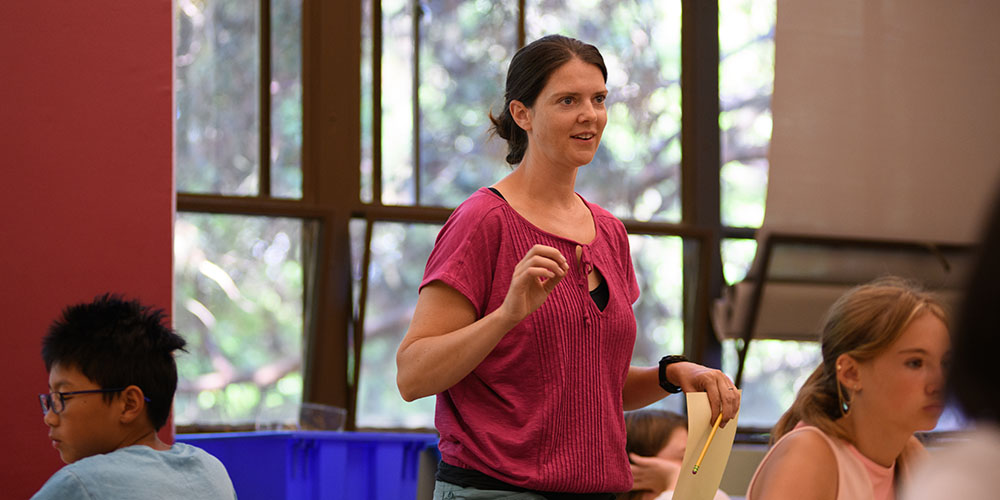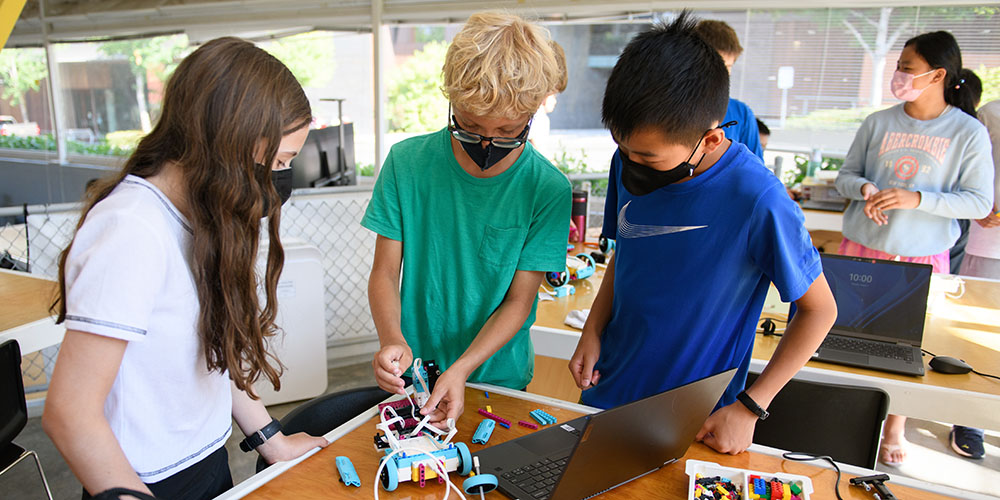University of Washington Youth & Teen Programs Instructors Cole Kopca and Caitlin Chamberlin Creatively Craft Curriculums to Offer Enrichment for Students in Grades 4-12
There are many summer and after-school programs out there, but only UW Youth & Teen Programs provides unparalleled access to the UW's world-class experts and resources. Every year, the program offers more than 40 courses ranging from creative writing to coding in Java, designed to make learning fun for students in grades 4-12.

Caitlin Chamberlin teaching class.
Taught by UW partners and instructors like Cole Kopca, who teaches Introduction to Autonomous Cars, and Caitlin Chamberlin, who teaches NanoCamp!, Youth & Teen Programs courses give students the opportunity to learn for the love of learning and explore a passion or get a taste of a topic they might want to learn more about without the pressure of grades. The courses also allow the Youth & Teen Programs team to collaborate with partners to think creatively and extend their reach.
Creating Captivating Courses
Assistant director of the UW Pacific Northwest Transportation Consortium (PacTrans), Cole was encouraged by federal funders to get creative with his programming to help breathe new life into the struggling transportation industry workforce. His team at the PacTrans Workforce Development Institute came up with the idea to create a science, technology, engineering and mathematics (STEM) outreach program to get younger students interested in the field. Looking for help to create a curriculum that would keep them engaged, Cole turned to the Youth & Teen Programs team.
We want to find those kids who don't think they're good at STEM or haven't experienced any practical application that piques their interest in STEM. That's how you grow STEM, as opposed to taking the kids who are already in STEM and giving them more activities.
— Cole Kopca, Assistant Director, UW Pacific Northwest Transportation Consortium
“We developed a course where students could build and play with a robot kit and learn from guest speakers about autonomous vehicles and other areas of transportation that include robotics,” explains Cole. “The Youth & Teen Programs staff provided our guest speakers with tips for connecting with students, such as doing hands-on activities or getting the students moving around, which helped set the speakers up for success.”
Similarly, Youth & Teen Programs’ desire to increase the number of STEM-focused courses for middle school students led Caitlin, who’s been an educator for a long time in various capacities, including as a classroom teacher at Bertschi School in Seattle for eight years, to develop an offering in collaboration with UW’s Molecular Engineering Materials Center (UW MEM-C).
The summer of 2023 is her third year working with one of the UW MEM-C’s Ph.D. students to co-teach NanoCamp!, designed for incoming sixth to eighth-grade students in the Seattle area. “The goal is to bring some level of expertise to nanoscience,” she explains. “And then I, as the educator, make sure we develop a curriculum that is accessible and engaging for the students so they can understand the information.
Both programs aim to find students who might explore other areas and bring them into the STEM world. “We want to find those kids who don't think they're good at STEM or haven't experienced any practical application that piques their interest in STEM,” Cole says. “That's how you grow STEM, as opposed to taking the kids who are already in STEM and giving them more activities.”
Sparking an Interest
Whether her students visit different research labs or build models in class, Caitlin hopes her course allows students to unleash their curiosity and explore a passion. “For middle schoolers to be diving into nanoscience or electronics in the way that these courses have made possible is not something you find in a typical elementary or middle school,” she says. “I think giving kids these opportunities earlier teaches students from a variety of backgrounds they're capable of taking on these complex topics.”

UW Youth & Teen students explore building autonomous vehicles.
The chance to work with renowned scientists and professionals of all backgrounds is another perk and lets students imagine themselves in the role.
“We work with a variety of scientists on campus, including those who work at the Nanofabrication Facility in Fluke Hall and others who conduct research in the Molecular Engineering and Sciences building on campus. Visiting these places on campus allows students to see the wide variety of people involved in the field,” Caitlin says. “For students to see women and people of color represented in places of leadership in STEM fields is powerful.”
Not only does the exposure to life on campus give students a window into what their educational experience can be, but it also lets them explore the different paths available. “I think many students go through college not realizing how many opportunities exist,” Cole says. “Getting these students familiar with the idea that if they like robotics, going into a field like transportation is an option.”
You can help youth and teens in your community study topics not offered in schools through a variety of UW summer and after-school enrichment programs.
